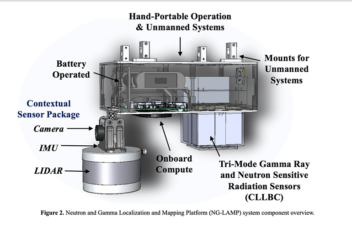For decades, the LBNL Semiconductor Detector Lab (SDL) has been at the forefront of advancements in gamma-ray detector technology. Amongst the technologies pioneered at the SDL are double-sided high-purity germanium (HPGe) strip detectors with amorphous germanium (a-Ge) contacts [1] (Fig. 1). These devices find application in a range of areas including basic science, nuclear security, medical imaging, and gamma-ray astronomy. Using this technology, SDL researchers have designed, developed, and built detectors for multiple instruments for astrophysics projects led by the Space Sciences Laboratory at UC Berkeley [2]. These include the Compton Spectrometer and Imager (COSI) [3-6] and the Gamma-Ray Imager/ Polarimeter for Solar Flares (GRIPS) [7-9], which were successfully flown on balloon missions for NASA.
news
Applied Nuclear Physics Program Aiding Clean-up of Cold War-Era Radioactive Contamination through Radiological Mapping
From 1955–1988, low-level waste solutions from the processing of uranium and irradiated nuclear fuel were discharged into unlined earthen storage basins at the Savannah River Site (SRS) F-Area [1]. Over the decades, radioactive contaminants including uranium and iodine-129 (I-129) have leaked out of the basins and into the groundwater of the surrounding wetlands, and are now present at levels that exceed regulatory thresholds.
R&D 100 of the day: The Neutron and Gamma Ray Source Localization and Mapping Platform 2.0
By Heather Hall | January 21, 2022

The Neutron and Gamma Localization and Mapping Platform (NG-LAMP), developed by Lawrence Berkeley National Laboratory, is the first ever portable system for simultaneous imaging and mapping of gamma ray and neutron radioactivity in three-dimensions (3D) and in real-time. Unlike all other portable, commercially available radiation imaging systems, which image and map radiation signatures in only one or two dimensions, NG-LAMP creates 3D reconstructions of both the environment surrounding the detector and radioactivity. This allows users to visualize and quantify the distribution of radiation signatures with contextual information about the measurement environment. Moreover, these capabilities are integrated into a compact, lightweight platform designed for hand-portable operations and operations on unmanned aerial and ground vehicles. The device addresses multiple nuclear security, nuclear safeguards and nuclear decontamination and remediation needs. The size and weight of NG-LAMP permits efficient deployment to U.S. military, international inspectors, and law enforcement personnel conducting search and interdiction operations in support of countering nuclear threats and mitigating human exposure to radioactivity
First paper on Semi-Autonomous 3D aerial mapping published!
Our Immersive Technology team which consists of students and scientists from the Departments of Electrical Engineering and Computer Science and Nuclear Engineering at UC Berkeley and some of our ANP scientists recently published a first paper on “Immersive Operation of a Sem-Autonomous Aerial Platform for Detecting and Mapping Radiation”.
This is a wonderful accomplishment by one of our multi-disciplinary teams and demonstrates for the first time the remote operation and visualization of a 3D Scene-Data Fusion enabled aerial platform. Please check it out!
—————–
Figures and captions:

Workflow of deploying a radiation-mapping mission between an sUAS (left) and the VR interface (right). Waypoints are placed on the 3-D map in VR and transmitted over WiFi as geolocated flight targets for the sUAS to reach semi-autonomously. Operators can view the real-time LAMP radiation and surface reconstruction from the sUAS in VR.

User can equip a VR headset and control the sUAS with VR controllers.

Our VR interface displays a textured 3-D view of the environment derived from prior satellite imagery. The operator sets waypoints through the VR interface to mark important flight path geo-locations. The sUAS (red) follows the flight path (yellow) around the building, detecting and streaming radiation and environment reconstruction data back to the interface as a colorized 3-D mesh (not shown here). The operator uses their virtual hands to select from the left-controller’s sensors and flight-control menus via the cyan pointer to control sensor data visualizations and sUAS operation, respectively.

Our system streams radiation and environment reconstruction data back to the VR interface, shown here, as colorized 3-D meshes. The environment reconstruction (top, in purple) is generated by the LAMP’s LiDAR and is used for the radiation reconstruction. We overlay the environment reconstruction on the baseline map to provide an accurate, real-time view of the sUAS’s surroundings to the operator. The radiation-only visualization (bottom) shows reconstructed intensities of 662-keV reflecting measurements of the gamma-ray energies with the CLLBC-based NG-LAMP. Higher gamma-ray intensities are denoted by darker shades of red. Note we display only the five (of six) most intense gamma-ray isosurfaces for visualization purposes. The operator can therefore intuitively localize the source to the darkest part of the mesh. For reference, the square building has a side length of about 8 m.
Berkeley Lab Honored with Three R&D 100 Awards
Three technologies from the U.S. Department of Energy’s (DOE) Lawrence Berkeley National Laboratory (Berkeley Lab) have won a 2021 R&D 100 award, representing innovations for memory and logic chips, next-generation batteries, and radiation detection and mapping.
Presented by R&D Magazine, the R&D 100 Awards, which are selected by an independent panel of judges, recognize the year’s 100 most innovative and disruptive technology products from industry, academia, and government-sponsored research. Established in 1963, the R&D 100 Awards is the only science and technology awards competition that recognizes new commercial products, technologies, and materials for their technological significance that are available for sale or license.
Go here to see all of the winners. The three awards this year brings the total of Berkeley Lab R&D 100 wins to 108, including two Editors’ Choice Awards. The winners were honored in virtual awards ceremonies from Oct. 19-21, 2021.
Congratulations to Jaewon Lee!

Jaewon Lee, one of our graduate students from the UC Berkeley Department of Nuclear Engineering won 3rd place in the student competition at the recent IEEE Nuclear Science Symposium and Medical Imaging Conference, one of our major conferences of the year.
He received this award for his outstanding presentation titled “Single Detector 3D Source Imaging Using a Kullback-Leibler Divergence Based Prior”. This work which he performed in collaboration with ANP’s Tenzing Joshi and Ren Cooper improves the localization and mapping of radioactive materials in three dimensions in unconstrained environments overcoming limitations in conventional approaches. This is a wonderful accomplishment and a well-deserved award for him.